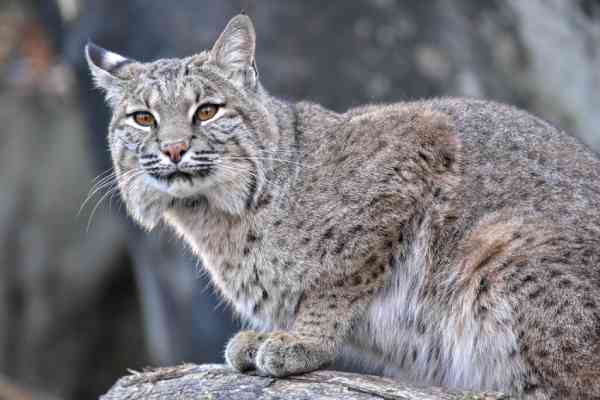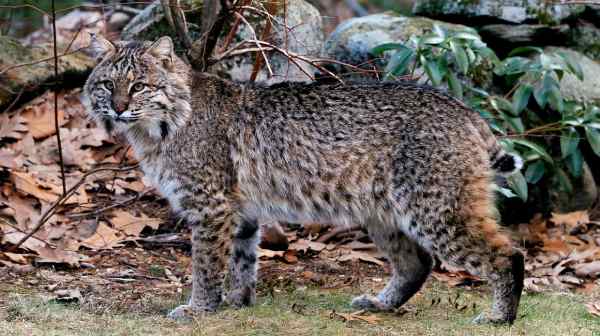The American Bobcat is a remarkable creature that often prowls undetected in North America’s forests and mountains. This stealthy predator employs impressive hunting tactics, including the ambush technique.
Table of Contents
The bobcat silently approaches its prey from behind, careful not to make any noise or movements that might alert its victim. Then, in an instant, the big cat pounces, using its powerful legs and sharp claws to take down its prey. The bobcat’s remarkable hunting prowess is a testament to its incredible ability to blend into its environment and to keep its presence wholly hidden until the opportune moment.
As we delve into the unseen hunter’s world, we will discover the fascinating behaviour of these stealthy predators and how they execute their lethal attacks.
Comparison Table of a Bobcat Ambushes a Deer
| Aspect | Bobcat | Deer |
| Size | Medium-sized | Varies depending on the species and age |
| Weight | Adult male bobcats: 20-30 pounds. Adult female bobcats: 15-20 pounds | Varies depending on the species and age |
| Physical Appearance | Short, reddish-brown fur with black spots | Varies depending on the species and age |
| Hunting Behavior | A stealthy and cunning predator | Prey species, grazer or browser |
| Predation | Hunts small mammals, birds, and sometimes deer | Preyed upon by bobcats and other predators |
| Adaptations | Retractable sharp claws, powerful jaws, exceptional eyesight | Agile runners, keen senses, antlers (in males) |
| Social Behavior | Mostly solitary, except during mating and raising young | Often form herds, social interactions |
| Ecosystem Role | Helps control prey populations, maintains ecosystem balance | Important herbivores, shape vegetation communities |
Anatomy And Adaptations Of The Bobcat

The bobcat, a medium-sized wild feline found throughout North America from southern Canada to central Mexico, possesses distinct physical features. It sports short, reddish-brown fur adorned with black spots that cover its body.
Mature male bobcats usually weigh between 20-30 pounds, while females typically weigh around 15-20 pounds. They measure about 2-3 feet in length, with their tails spanning approximately 6 inches.
Bobcats exhibit various physical attributes that render them adept hunters. Their retractable sharp claws facilitate silent stalking and tree climbing. Notably, acute eyesight allows them to spot prey from afar, even in dim lighting. Additionally, their exceptional hearing makes them highly responsive to sounds such as the movements of potential targets.
In their natural habitat, bobcats have developed behavioral adaptations that contribute to their survival and prosperity. Their preference for a solitary lifestyle sets them apart from other wildcats that often live and hunt in groups. This solitary approach enhances their hunting efficiency and helps them avoid territorial and food-related conflicts.
Another behavioral adaptation involves their inclination towards nocturnal activities. By being primarily active at night, they align with the active hours of their prey species. The darkness serves as an advantage, as their dark fur blends in with the environment, making them inconspicuous to their prey.
The Ambush Technique: A Display Of Hunting Skill
The American Bobcat’s hunting prowess is most impressively demonstrated through its skilful use of the ambush technique. This stealthy predator excels at concealing itself amidst the dense shrubs and wooded areas of North America, patiently waiting for the opportune moment to strike.
When the time is right, the bobcat executes a lightning-quick assault, relying on its sharp claws and powerful jaws to swiftly take down its prey. Unlike other predators in the region, the bobcat relies on intelligence and cunning to outmaneuver its quarry before dealing the final decisive blow.
- The Ambush: A Stealthy Stalk
The bobcat’s ambush strategy is centered around patience and silence. The predator first identifies its target and then silently stalks it, making no noise to avoid detection. Experts estimate that bobcats can leap up to 15 meters in a single bound, granting them the ability to swiftly pursue their prey.
Once the bobcat is within striking distance, it launches a nearly soundless attack, catching the game off-guard with its incredible speed. The ambush technique allows the bobcat to conserve energy while delivering a powerful and precise strike—a perfect combination of strength and accuracy.

The Role Of Deer In Bobcat’s Diet
The American Bobcat is a highly adaptable predator with a diverse diet. While they are known to primarily feed on small mammals such as rabbits, rodents, and birds, deer play a significant role in their diet as well.
In regions where other prey options are scarce or unavailable, deer become a crucial food source for bobcats. These elusive animals provide the bobcat with essential proteins, contributing to their growth and maintaining their optimal physical condition.
Interestingly, despite the availability of larger prey like deer in the wild, bobcats also target smaller animals for sustenance. Hunting smaller creatures allows them to obtain food without expending excessive energy.
Bobcats are skilled hunters and employ various techniques and strategies to successfully capture their prey. Stalking is one such strategy, involving the bobcat stealthily approaching its target without being noticed. Once near, the bobcat swiftly pounces, delivering a lethal blow with its sharp claws, effectively incapacitating the victim.
Their hunting activities are primarily carried out during early mornings, late evenings, and at night, taking advantage of low visibility to sneak up on their prey. Additionally, their innate ability to blend seamlessly with the surroundings makes it challenging for the prey to detect their presence, giving bobcats an added advantage during the hunt.
Key Points of a Bobcat Ambushes a Deer
- The ambush technique stands as one of the most remarkable demonstrations of the American Bobcat’s hunting prowess. This stealthy predator is an expert at staying hidden in North America’s dense shrubs and wooded areas, patiently waiting for the perfect moment to strike.
- In terms of physical characteristics, adult male bobcats typically weigh between 20-30 pounds, while females weigh around 15-20 pounds. Their body length spans about 2-3 feet, and their tails are typically around 6 inches long.
- As a highly adaptable predator, the American Bobcat thrives on a varied diet, which includes a range of prey species.
- Their remarkable eyesight is another crucial adaptation, allowing them to spot potential prey from a distance, even in dim lighting conditions.
- Interestingly, despite the abundance of larger prey like deer in the wild, bobcats also tend to hunt smaller animals, as it provides them with a sufficient food source without requiring excessive energy expenditure.
FAQs
How stealthy are bobcats?
Bobcats are known for their stealthy behavior, often able to move about unnoticed. They have keen senses of hearing and sight, and their fur helps them blend in with their surroundings. Due to their elusiveness, it’s rare to see a bobcat in the wild. Their silent movements make them skilled hunters, able to sneak up on prey and pounce with incredible speed.
What is the description of a bobcat?
It’s a small to medium-sized feline equipped with sharp retractable claws that help them climb trees and hunt efficiently. Generally, bobcats have a compact muscular body, short stubby tail, and long legs with large paws, making them skilled predators. They have a beautiful reddish-brown coat, spotted with black stripes or dots, which acts as excellent camouflage in their environment.
Are bobcats sneaky?
Bobcats are known for their stealthy nature and are often associated with being sneaky. These elusive wild cats are highly adaptable and can thrive in a variety of environments, from forests to deserts. Their keen senses, sharp reflexes, and natural camouflage make them skilled hunters, and they can quietly stalk their prey without being detected.
Final Words
The bobcat’s evolutionary journey has shaped it into a captivating and efficient predator, earning its place as one of North America’s most skilled hunters. The ambush-hunting technique it employs showcases its remarkable stealth and agility, highlighting the intricate harmony of the natural world.
While we delve further into understanding and recording the behaviours of these magnificent creatures, it is essential to take proactive measures to safeguard them and preserve their vital role in the ecosystem. By protecting bobcats and their habitats, we contribute to the overall balance and health of the environment they inhabit.
Reference:
- https://portal.ct.gov/-/media/DEEP/wildlife/pdf_files/outreach/fact_sheets/bobcatpdf.pdf
- https://www.nps.gov/whsa/learn/nature/bobcat.htm
- https://nationalzoo.si.edu/animals/bobcat

Rahul M Suresh
Visiting the Zoo can be an exciting and educational experience for all involved. As a guide, I have the privilege of helping students and visitors alike to appreciate these animals in their natural habitat as well as introducing them to the various aspects of zoo life. I provide detailed information about the individual animals and their habitats, giving visitors an opportunity to understand each one more fully and appreciate them in a more intimate way.








